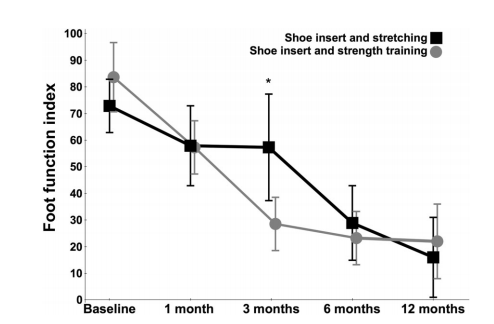Plantar fasciitis (also called plantar fasciopathy) is a common and sometimes difficult condition to treat.
The most common symptoms of plantar fasciitis are:
- dull heel pain which is worse in the morning
- pain that warms up with walking but can become worse again with longer walks
Plantar fasciitis is a bit like tendon pain in that a change in activity normally contributes to it becoming painful. Examples of change in activity may include:
- increasing total amount of running or walking
- introducing more hills to your fitness routine
- more 'high impact' activity such as jumping, sprinting
- a change in footwear
So how to we treat this condition? Traditional treatments have focused on things such as:
- long periods of rest
- blood injections (such as PRP)
- stretching
Unfortunately these treatments often prove to be unhelpful in resolving this condition. This is particularly true in the case of blood injections, which have been shown time and time again to be unhelpful in treating tendon problems (there is some promise for joint problems however, such as specific types of knee osteoarthritis).
Last year there was a fantastic randomised controlled trial which compared two different treatments for plantar fasciitis - strength exercises vs stretching. Each group received either 3 months of strength exercises, or 3 months of stretching exercises.
As with what we would suspect, as well as what is effective with other tendon type injuries, the strength group showed significantly improved function and pain after 3 months of rehabilitation
Figure 1: strength training vs stretching for plantar fasciitis
On the table to the right, you can see the primary outcome measure. Basically, higher scores show poorer function, while lower scores show better function.
Interestingly, both groups were similar at 12 months, which shows that:
- this condition may just improve given enough time!, or
- that the strength exercises need to be continued as an ongoing treatment (even after three months)
The full paper can be seen here if you are interested
Of course, other treatments may be beneficial for certain situations with people with plantar fasciitis. This depends on a variety of individual factors.
Dr John Orchard has written a great summary of the other treatments that may benefit this condition, they include:
- Shockwave therapy
- Orthotics
- Stretching (I'm dubious on this one but I'll leave it here!) and
- corticosteroid injection
So what are the take home messages? Plantar fasciitis can be tricky to treat. It often required a period of offloading from provocative activity such as running and jumping. Strengthening (not just the calves but the entire lower limb) can be beneficial.
I suspect that modifying running technique in some people will also be effective but this has yet to be proven with research.
Aidan Rich is an APA Sports Physiotherapist with Advance Healthcare in Boronia. Aidan has an interest in all Sports Medicine conditions, particularly those of the hip, groin and tendon.
The Boronia clinic services nearby suburbs such as Rowville and Ferntree Gully with Sports Physiotherapy, Pain Management and Psychology services.



